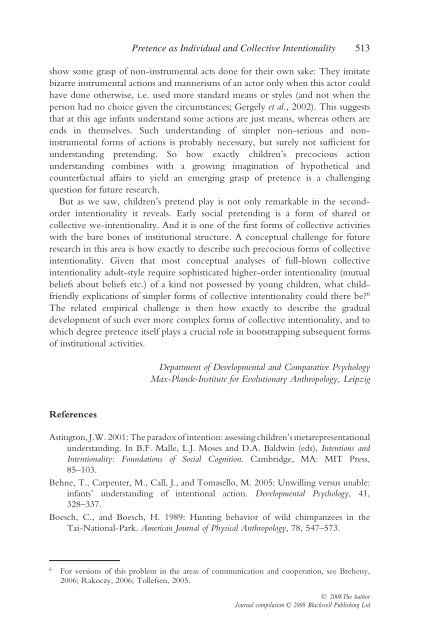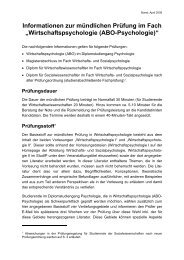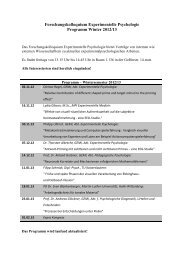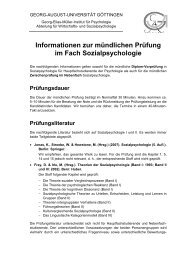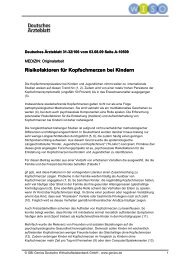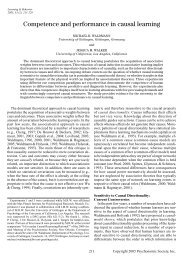Pretence as Individual and Collective Intentionality
Pretence as Individual and Collective Intentionality
Pretence as Individual and Collective Intentionality
Create successful ePaper yourself
Turn your PDF publications into a flip-book with our unique Google optimized e-Paper software.
<strong>Pretence</strong> <strong>as</strong> <strong>Individual</strong> <strong>and</strong> <strong>Collective</strong> <strong>Intentionality</strong> 51 3<br />
show some gr<strong>as</strong>p of non-instrumental acts done for their own sake: They imitate<br />
bizarre instrumental actions <strong>and</strong> mannerisms of an actor only when this actor could<br />
have done otherwise, i.e. used more st<strong>and</strong>ard means or styles (<strong>and</strong> not when the<br />
person had no choice given the circumstances; Gergely et al. , 2002 ). This suggests<br />
that at this age infants underst<strong>and</strong> some actions are just means, where<strong>as</strong> others are<br />
ends in themselves. Such underst<strong>and</strong>ing of simpler non-serious <strong>and</strong> noninstrumental<br />
forms of actions is probably necessary, but surely not suffi cient for<br />
underst<strong>and</strong>ing pretending. So how exactly children ’ s precocious action<br />
underst<strong>and</strong>ing combines with a growing imagination of hypothetical <strong>and</strong><br />
counterfactual affairs to yield an emerging gr<strong>as</strong>p of pretence is a challenging<br />
question for future research.<br />
But <strong>as</strong> we saw, children ’ s pretend play is not only remarkable in the secondorder<br />
intentionality it reveals. Early social pretending is a form of shared or<br />
collective we-intentionality. And it is one of the fi rst forms of collective activities<br />
with the bare bones of institutional structure. A conceptual challenge for future<br />
research in this area is how exactly to describe such precocious forms of collective<br />
intentionality. Given that most conceptual analyses of full-blown collective<br />
intentionality adult-style require sophisticated higher-order intentionality (mutual<br />
beliefs about beliefs etc.) of a kind not possessed by young children, what childfriendly<br />
explications of simpler forms of collective intentionality could there be? 6<br />
The related empirical challenge is then how exactly to describe the gradual<br />
development of such ever more complex forms of collective intentionality, <strong>and</strong> to<br />
which degree pretence itself plays a crucial role in bootstrapping subsequent forms<br />
of institutional activities.<br />
References<br />
Department of Developmental <strong>and</strong> Comparative Psychology<br />
Max-Planck-Institute for Evolutionary Anthropology, Leipzig<br />
Astington , J.W . 2001 : The paradox of intention: <strong>as</strong>sessing children ’ s metarepresentational<br />
underst<strong>and</strong>ing . In B.F. Malle , L.J. Moses <strong>and</strong> D.A. Baldwin ( eds ), Intentions <strong>and</strong><br />
<strong>Intentionality</strong>: Foundations of Social Cognition . Cambridge, MA : MIT Press ,<br />
85 – 103 .<br />
Behne , T. , Carpenter , M. , Call , J. , <strong>and</strong> Tom<strong>as</strong>ello , M. 2005 : Unwilling versus unable:<br />
infants ’ underst<strong>and</strong>ing of intentional action . Developmental Psychology , 41 ,<br />
328 – 337 .<br />
Boesch , C. , <strong>and</strong> Boesch , H. 1989 : Hunting behavior of wild chimpanzees in the<br />
Tai-National-Park . American Journal of Physical Anthropology , 78 , 547 – 573 .<br />
6 For versions of this problem in the are<strong>as</strong> of communication <strong>and</strong> cooperation, see Breheny,<br />
2006; Rakoczy, 2006; Tollefsen, 2005 .<br />
© 2008 The Author<br />
Journal compilation © 2008 Blackwell Publishing Ltd


